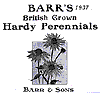Kortmann (1998)
peregrina 'Fire King' (Prichard, Engeland, 1899) Bloemen scharlakenrood (RHS CC 53B, Red Group), klein, enkel; meeldraden goudgeel; bladeren samengesteld, uiteinden licht ingesneden, groen; hoogte 60 cm; bloemstengels goed stevig; vertakking matig tot goed. Deze cultivar valt op door de warmrode kleur en de frisgroene bladeren. Vooral de pas geopende bloemen zijn zeer aantrekkelijk. Ondanks dat deze cultivar iets gevoelig is voor Botrytis, is een positieve waardenng door de vele goede eigenschappen gerechtvaardigd.
A.P. Saunders: PEONY SPECIES (Other than albiflora and moutan) in: Peonies, The Manual of the American Peony Society, edited by James Boyd © 1928 American Peony Society:
P. officinalis. Southern Europe. This species has been cultivated in European gardens for centuries, and has given rise to a number of. brilliant and lovely varieties. There is much confusion regarding those which are to be traced back to P. officinalis and those derived from P. paradoxa.
Vilmorin ("Fleurs de Pleine Terre") separates two groups under these two specific names; and he states that those derived from P. paradoxa are easily distinguished by the glaucescence (bluish greenness) of the foliage. Unfortunately, Vilmorin does not include in nis list by any means all of the varieties which are, or have been, in commerce.
Since these forms when offered in nurserymen's lists are usually grouped all together under P. officinalis, I have listed them all here, making a separate group of those which, according to Vilmorin, should be referred to P. paradoxa.
A further complication arises from the fact that several varieties have been produced from P. lobata. This is itself to be considered as a variety of P. officinalis, and it is not always possible in the case of named varieties to say whether they should be referred to P. lobata or to the broader species P. officinalis.
Varieties probably referable to P.officinalis:
alba mutabilis
alba plena
atrorubra plena
anemoneflora
blanda
carnea plena. Syn. alba mutabilis
carnescens
Ceres
Charmer
Eclair. Syn. alba mutabilis
Fire King
fulgens
incarnata plena. Syn. alba mutabilis
Lize van Veen. Sport from P. rosea superba, which has been recently introduced into commerce in Holland.
lobata : Otto Froebel, Sunbeam
maxima rosea plena
Ophia
Oriflamme
purpurea plena
rosea (single)
rosea pallida plena. Syn. alba mutabilis
rosea plena
rosea superba plena (rated 8.2 in symposium, 1925)
rubra plena (rated 8.6 in symposium, 1925)
Sabini
sanguinea plena
splendens
striata elegans
The Sultan
listed by:


In Laub, Blütenform und Wuchs eindeutig ein Peregrina.-Kultivar


peregrina/officinalis cultivar
Die genaue Zuordnung von Staudenpfingstrosen dieser Gruppe ist insofern problematisch, daß viele im 20. Jahrhundert als „Paeonia officinalis“-Kultivare bezeichnete Sorten eigentlich Abkömmlinge von Paeonia peregrina sind. Bis in die 1930er Jahre hießen auch die Peregrinas alle Paeonia officinalis. Ich bezweifle, daß ein Großteil dieser Gruppe irgendetwas mit Paeonia officinalis zu tun hat, angefangen bei der allseits bekannten Bauernpfingstrose „Officinalis Rubra Plena“, die entweder ein Kultivar von Paeonia peregrina ist oder (wahrscheinlicher) eine Hybride aus Paeonia peregrina und einer anderen Wildart, vielleicht Paeonia officinalis. Um dieses Zuordnungsproblem zu umgehen, hier die Gruppe „p/o“: Sorten, die im Wuchs, Blütenstellung, Laub und Farbe Paeonia peregrina ähneln bzw. Paeonia 'Officinalis Rubra Plena'. Die Zuordnung zu den Hybriden erfolgt wegen der bestehenden Unsicherheiten nicht.


